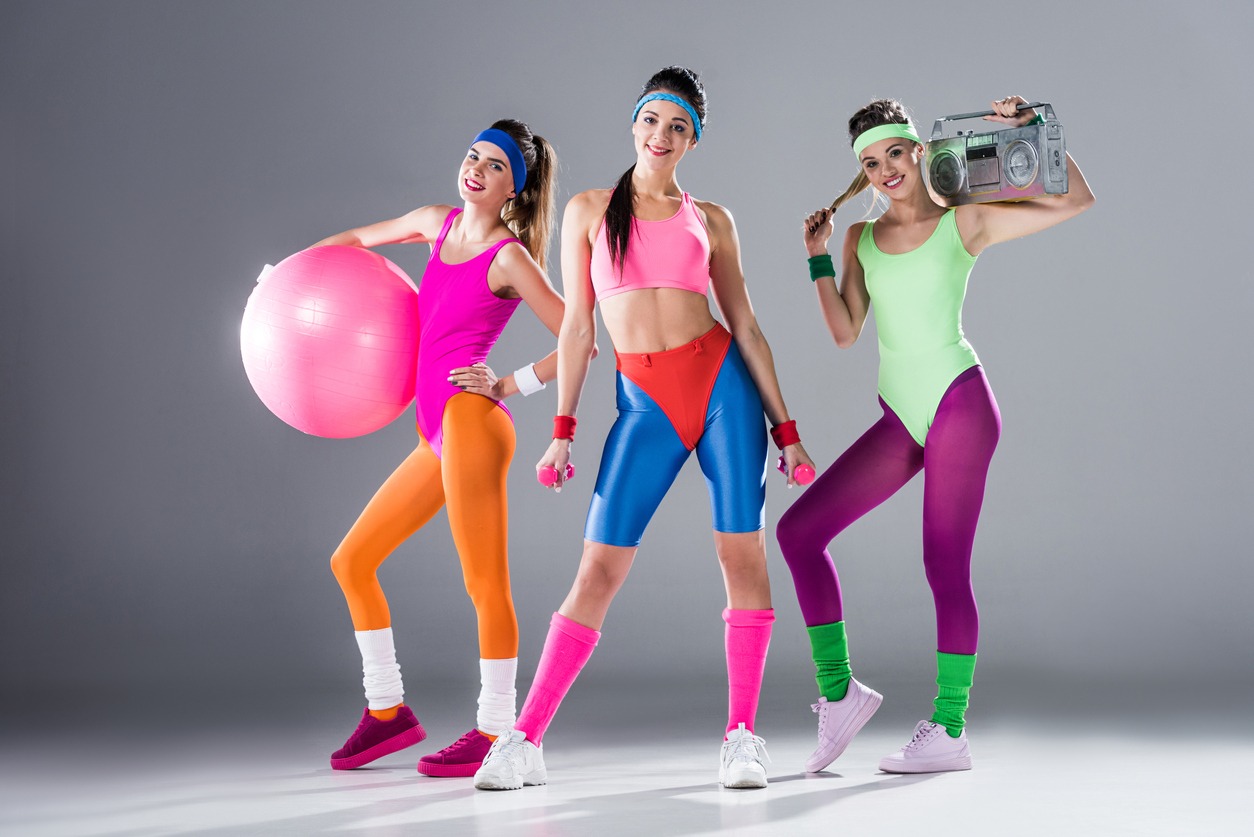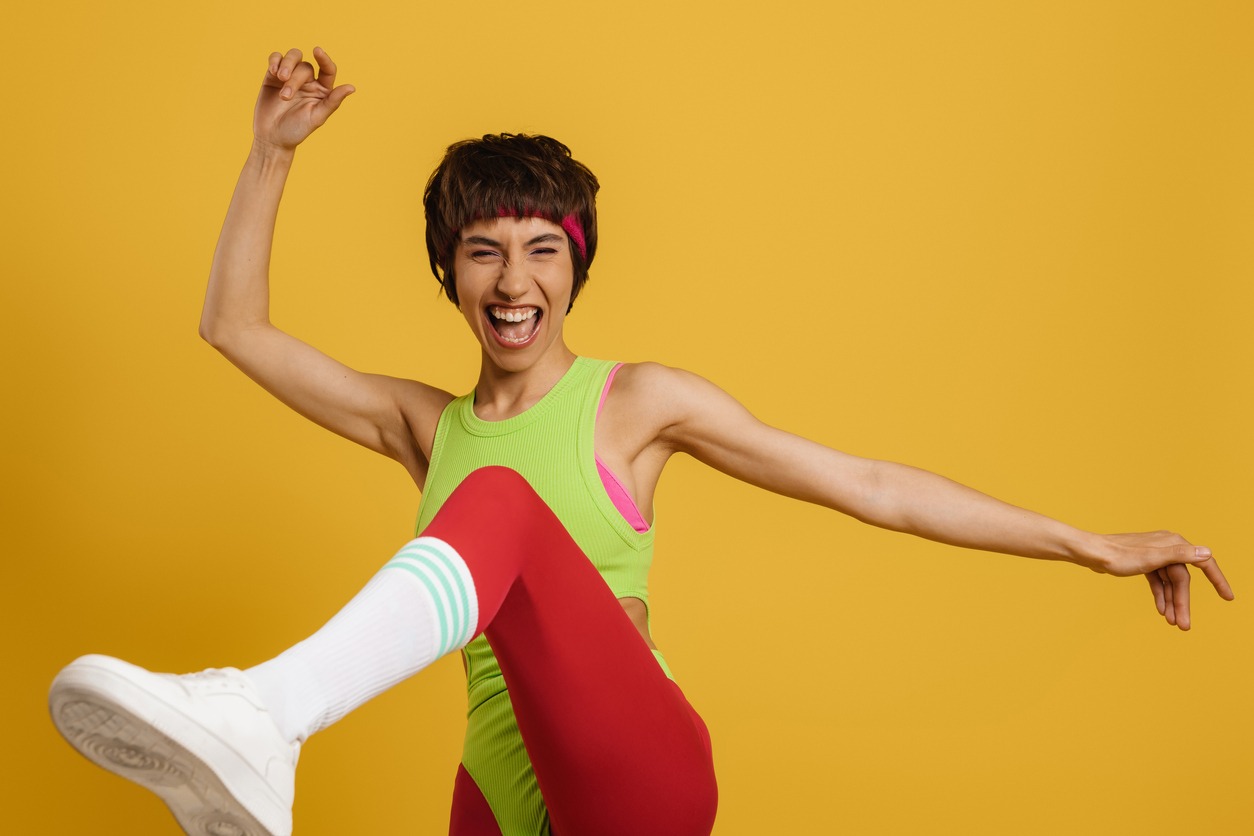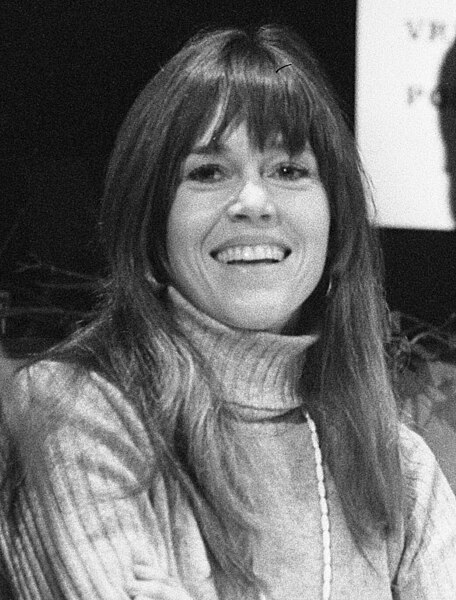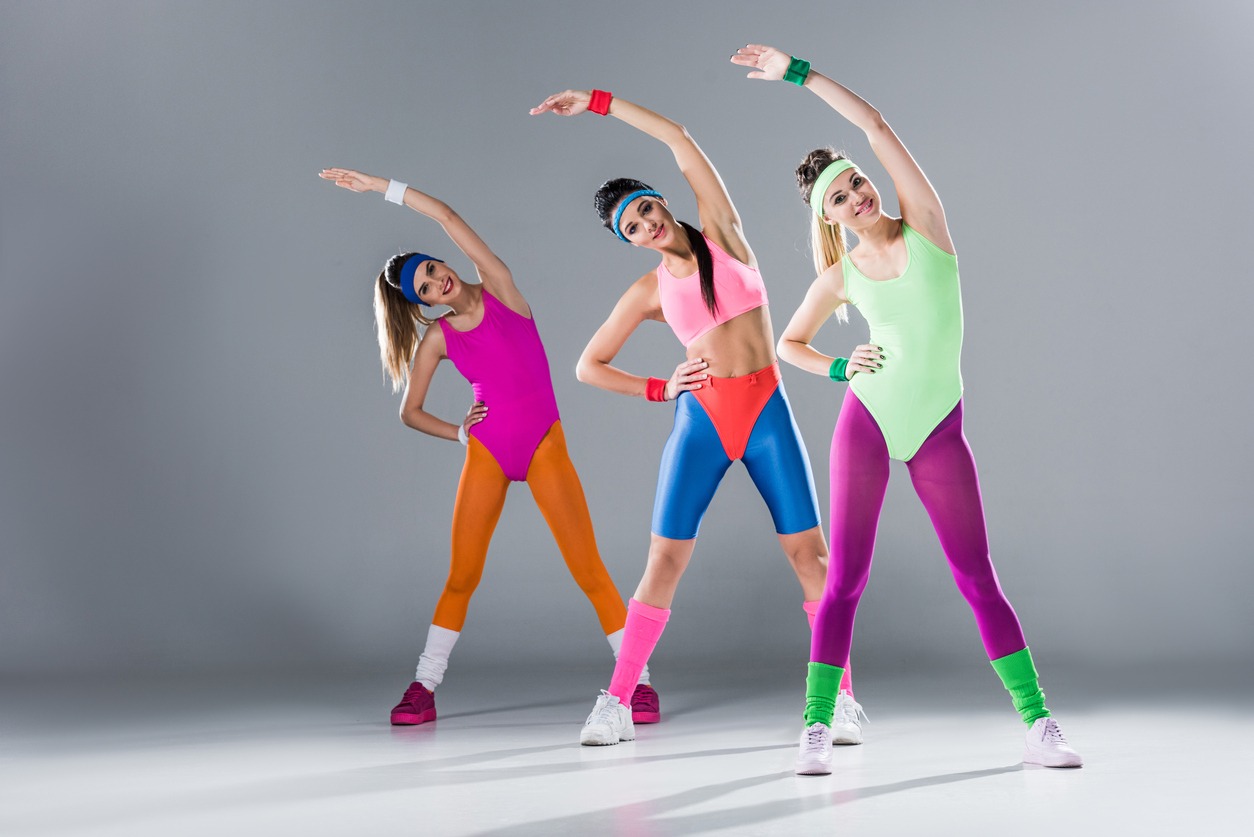In the 1980s, a fitness revolution took over living rooms across the world, fueled by the advent of home fitness videos. This era marked a significant shift in how people approached exercise, moving from gym-based workouts to embracing the convenience of exercising at home. Central to this movement were fitness icons like Jane Fonda, whose workout videos not only became a cultural phenomenon but also redefined the fitness industry.
The fitness video craze of the 80s was a reflection of the changing attitudes towards health and wellness and the growing accessibility of home video technology. These workout videos, characterized by energetic aerobics and charismatic instructors, tapped into the era’s emphasis on physical fitness and appearance. This article explores the catalysts behind this craze, examining how figures like Jane Fonda sparked a fitness movement that resonates even today.
The Rise of Home Exercise Videos
The 1980s saw a groundbreaking shift in the fitness world with the emergence of home exercise videos. This trend not only changed how people worked out but also brought about a new era in the health and fitness industry.
Emergence of the VCR Technology
The widespread availability of VCRs (Video Cassette Recorders) in the early 1980s played a crucial role in the rise of home exercise videos. For the first time, it became possible to easily watch and follow exercise routines in the comfort of one’s home. The VCR technology offered unprecedented convenience, allowing people to exercise on their own schedule, an appealing prospect for those with busy lifestyles or limited access to gyms.
The Transition from Gym to Home Workouts
Prior to the 1980s, exercise routines were largely confined to gyms and fitness centers. Home exercise videos opened up a new avenue for fitness, particularly appealing to those intimidated by gym environments or seeking a more private workout experience. These videos introduced a variety of workouts that could be done at home, from aerobics and strength training to yoga and dance-based fitness.
The Role of Media and Marketing
Fitness videos were heavily marketed through television commercials and fitness magazines, reaching a wide audience and creating a buzz around home workouts. The involvement of celebrities in fitness videos added an element of glamour and aspiration, encouraging more people to try out these home workouts.
The Economics of Fitness Videos
Purchasing a fitness video was a cost-effective alternative to gym memberships, making it an attractive option for a wider demographic. The popularity of these videos created a lucrative market for fitness instructors and celebrities, leading to a surge in the production of home workout content.
The rise of home exercise videos in the 1980s was a pivotal moment in the fitness industry. Powered by technological advancements and innovative marketing strategies, it represented a shift towards more accessible and diverse forms of exercise, laying the groundwork for the modern fitness landscape. This trend not only made fitness more attainable for the average person but also sparked a lasting enthusiasm for health and wellness.
Learn more about the other fitness trends of the decade in our post about the defining fitness and exercise trends of the 1980s.
Jane Fonda’s Pioneering Role
In the realm of home fitness videos, Jane Fonda stands out as a pioneering figure whose influence in the 1980s was nothing short of revolutionary. Her entry into the fitness world became a cultural phenomenon that reshaped how people approached exercise and wellness.
Before her foray into fitness, Jane Fonda was already a well-known actress and activist. Her decision to create a workout video was initially motivated by the need to fund her political campaigns. Released in 1982, Jane Fonda’s first workout video, “Jane Fonda’s Workout,” was an instant success. It became the highest-selling VHS of the time, eventually selling over 17 million copies.
Fonda’s workout videos were instrumental in popularizing aerobics and making exercise more accessible, especially to women who were looking for new ways to stay fit. Her approachable demeanor and well-structured routines made fitness seem attainable for the average person. She successfully combined rigorous exercise with a sense of fun and empowerment.
Fonda’s videos covered a range of fitness routines, from beginner to advanced levels, including aerobics, strength training, and yoga. This variety catered to a broad spectrum of fitness enthusiasts. Beyond just workouts, her videos often included advice on diet and wellness, promoting a holistic approach to health.
Jane Fonda’s videos set high production standards for future fitness videos. Her attention to detail, incorporation of expert advice, and professional production values raised the bar in the fitness video industry. Fonda’s influence extended beyond the 80s, inspiring a wave of celebrity-led fitness videos and programs. She paved the way for celebrities to leverage their influence in promoting health and fitness.
Jane Fonda’s pioneering role in the fitness video craze of the 1980s was a key factor in the explosion of this industry. She not only democratized fitness, making it accessible and enjoyable for the masses but also left an indelible mark on how exercise was perceived and practiced. Her legacy in the fitness world endures, underscoring the impact that one individual can have on changing health and exercise culture.
Celebrity Influence and Marketing
The 1980s fitness video craze was significantly bolstered by the influence of celebrities and strategic marketing. This era saw a fusion of fitness and fame, with celebrities not only promoting fitness products but also becoming synonymous with the workouts themselves.
Celebrity Endorsements and Fitness Brands
Celebrities like Jane Fonda weren’t just endorsing fitness products; they were the face of their own brands. Their involvement added a layer of credibility and aspiration to home workouts. Other celebrities, including actors and athletes, followed Fonda’s lead, releasing their own branded workout videos. This trend underscored the power of celebrities in influencing public behavior and trends.
Marketing Strategies
Aggressive marketing campaigns on television and in print media played a crucial role in promoting fitness videos. These ads often highlighted the transformative potential of the workouts and the celebrity’s personal endorsement. Fitness videos were among the early adopters of the direct-to-consumer marketing approach, using infomercials and direct mail to reach potential buyers.
Role of Media in Popularizing Fitness Videos
Fitness videos frequently received coverage in popular magazines and talk shows, further boosting their popularity. This media attention often included interviews with the celebrities behind the videos, workout tips, and success stories from users. Fitness videos became a cultural phenomenon, with references in movies, TV shows, and other forms of entertainment, reflecting and reinforcing their popularity.
The Appeal of Celebrity Fitness Routines
Celebrity-led workouts offered an aspirational quality, promising not just fitness but also a connection to the glamorous world of the celebrities endorsing them. These videos often portrayed the celebrities in a more personal and relatable manner, creating a sense of connection and trust with the audience.
Evolution of Fitness Marketing
Marketing for fitness videos evolved from selling a product to promoting a lifestyle. This shift played a crucial role in how fitness was perceived, turning it into a desirable and integral part of daily life.
The convergence of celebrity influence and innovative marketing was a driving force behind the 1980s fitness video craze. This era demonstrated the powerful impact of combining star power with effective marketing strategies, forever changing the landscape of fitness promotion and consumer behavior. The celebrity fitness video phenomenon of the 80s paved the way for the modern fitness industry, where fame and fitness often go hand in hand.
Cultural and Social Factors
The 1980s fitness video craze was not only a commercial phenomenon but also a reflection of the cultural and social dynamics of the time. Various factors contributed to the environment that made fitness videos not just popular but also a significant aspect of the decade’s lifestyle.
- Emphasis on Physical Fitness and Appearance: The 1980s saw an increased emphasis on physical fitness, partly as a response to rising concerns over health and lifestyle diseases. Being fit became synonymous with being healthy, successful, and attractive. Television, movies, and magazines of the time often portrayed a certain body image as the ideal, fueling a societal drive towards achieving that standard through fitness.
- Changing Roles and Lifestyles: The rise in the number of women entering the workforce led to a demand for more convenient forms of exercise that could fit into busy schedules. Home fitness videos provided a perfect solution. For many women, these fitness routines were not just about physical health but also about empowerment and taking control of their bodies and well-being.
- The Aerobics Movement: Aerobics became a trendy form of exercise in the 1980s, characterized by its energetic, dance-like routines. Fitness videos capitalized on this trend, making it accessible to a wider audience. Aerobics classes, often portrayed in media and popular culture, became a social activity, a place to see and be seen, which was mirrored in the communal aspect of following a fitness video at home.
- Technological Advancements: The proliferation of VCRs made it feasible for people to watch and participate in workout videos at home, aligning with the era’s growing fascination with technology and convenience.
- Economic Prosperity: The economic prosperity of the 1980s meant that more people had disposable income to spend on items like VCRs and workout videos, fueling the market for home fitness products.
- Health Awareness Campaigns: There was a significant public health push during the 1980s to combat sedentary lifestyles and promote physical activity, which dovetailed neatly with the marketing of fitness videos.
The 1980s fitness video craze was deeply intertwined with the cultural and social fabric of the time. It was a response to changing attitudes towards health, fitness, and body image and was facilitated by technological advancements and economic factors. The legacy of this era is a continued focus on health and fitness in popular culture, albeit adapted to new generations and technologies.
Evolution of Fitness Trends in the 80s
The 1980s were not just about the rise of fitness videos; the decade was a pivotal period in the evolution of fitness trends overall. This era saw a shift in exercise styles, methods, and the overall perception of fitness in daily life.
From Traditional Exercise to Aerobics
The early part of the decade was marked by traditional forms of exercise, such as jogging, weight training, and calisthenics. As the decade progressed, aerobics emerged as the dominant fitness trend. Its high-energy, dance-inspired routines offered a fun and engaging way to exercise, shifting the focus from purely physical exertion to enjoyment and lifestyle.
Influence of Popular Culture
The depiction of aerobics in movies, television shows, and celebrity endorsements played a significant role in popularizing this form of exercise. Aerobics also influenced fashion, with workout attire becoming a style statement characterized by bright colors, leotards, leg warmers, and headbands.
Innovations in Fitness Equipment and Facilities
The fitness boom led to the proliferation of home exercise equipment like stationary bikes, treadmills, and rowing machines. Health clubs and gyms expanded and became more sophisticated, offering a wider range of classes and services to cater to the growing fitness-conscious population.
Diversification of Fitness Programs
The 80s saw the development of specialized fitness programs targeting specific demographics, such as seniors, children, or those with specific health needs. New forms of exercise like step aerobics, jazzercise, and water aerobics also emerged, broadening the scope of fitness offerings.
Fitness for Health vs. Aesthetics
While much of the fitness craze was driven by aesthetic goals, there was also a growing emphasis on fitness for health, wellness, and longevity. Government and health organizations began to emphasize the importance of regular exercise, contributing to a more health-conscious society.
The Role of Fitness Videos
Fitness videos played a crucial role in this evolution by making various forms of exercise accessible to a wider audience beyond the confines of gyms and fitness centers. These videos popularized the concept of effective home workouts, leading to changes in how and where people chose to exercise.
The evolution of fitness trends in the 1980s reflects a period of significant transformation in how people approached physical health and exercise. It was a time when fitness became embedded in popular culture, lifestyle, and daily routines, setting the stage for the health and wellness movements that continue today.
Impact on the Fitness Industry
The fitness video craze of the 1980s had a profound and lasting impact on the fitness industry. This period of innovation not only changed how people exercised but also reshaped the business and cultural landscape of fitness.
- Expansion of the Home Fitness Market: The popularity of fitness videos in the 80s led to a surge in the sales of home exercise equipment. As people sought to replicate gym experiences at home, there was an increase in demand for items like treadmills, stationary bikes, and weights. The market expanded to include a variety of products tailored to home workouts, from simple aerobics mats to more complex exercise machines.
- Emergence of New Fitness Brands and Personalities: The success of celebrities like Jane Fonda opened the door for other fitness personalities to establish their brands. These individuals became influential in the industry, promoting their unique methods and philosophies. The fitness craze led to the creation of branded merchandise, ranging from workout clothing to fitness accessories, further commercializing the industry.
- Influence on Gym Culture and Classes: The group exercise dynamic popularized by aerobics videos inspired gyms to offer a wider range of group fitness classes. This trend helped retain gym memberships and attract a broader clientele. Traditional gyms began incorporating elements from popular videos into their programs, adapting to the changing preferences of fitness enthusiasts.
- Shift in Marketing and Advertising Strategies: Marketing in the fitness industry shifted from purely promoting physical benefits to emphasizing a holistic approach to health and wellness. Fitness advertising became more sophisticated, using motivational messages and aspirational imagery to attract consumers.
- Long-term Health and Fitness Awareness: The 80s fitness video craze played a significant role in raising public awareness about health and fitness, contributing to a more health-conscious society. The popularity of these videos helped pave the way for future fitness trends and movements, such as the rise of yoga, Pilates, and, more recently, digital fitness platforms.
- Professional Development in Fitness: The industry saw a push for higher standards and professional certifications for fitness instructors, partly influenced by the professionalism seen in popular fitness videos.
The 1980s fitness video craze had a ripple effect across the fitness industry, driving innovation, expanding markets, and influencing both consumer behavior and business models. Its legacy is evident in the continued evolution and diversification of fitness offerings, reflecting the enduring impact of this pivotal era on the way we view and engage with personal fitness.
Conclusion
The fitness video craze of the 1980s, led by icons like Jane Fonda, marked a significant turning point in the world of health and fitness. This era not only introduced a new, accessible way to exercise through home videos but also ignited a widespread enthusiasm for personal fitness. The influence of these trends is still visible today in how fitness is marketed, consumed, and integrated into daily life. As we look back, it’s clear that the legacy of the 80s fitness video craze extends far beyond the era, continuing to shape the fitness industry and our attitudes towards health and exercise. Delving into the explosion of 80s fitness videos reveals the era’s cultural shift towards health and exercise, spearheaded by luminaries like Jane Fonda. How Did the Fitness Craze of the 80s Start and Who Were Its Icons? offers an in-depth look at the movement’s origins and key figures, tracing how their influence shaped a generation’s approach to fitness.




